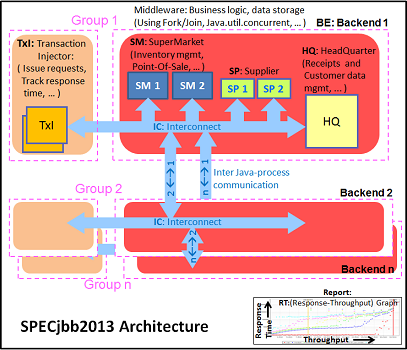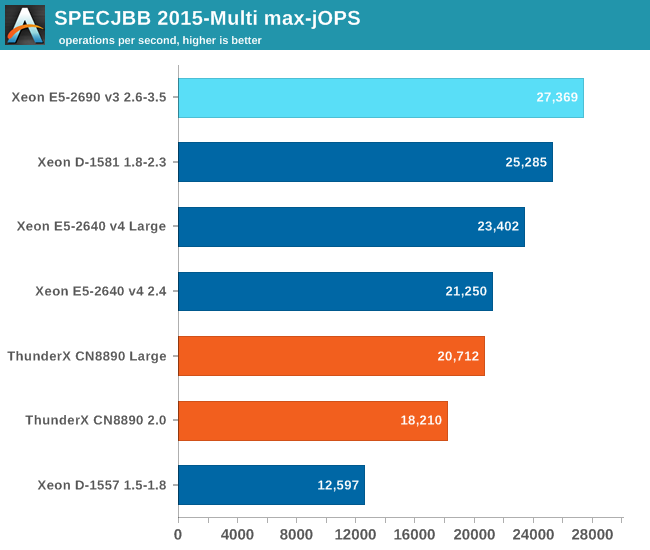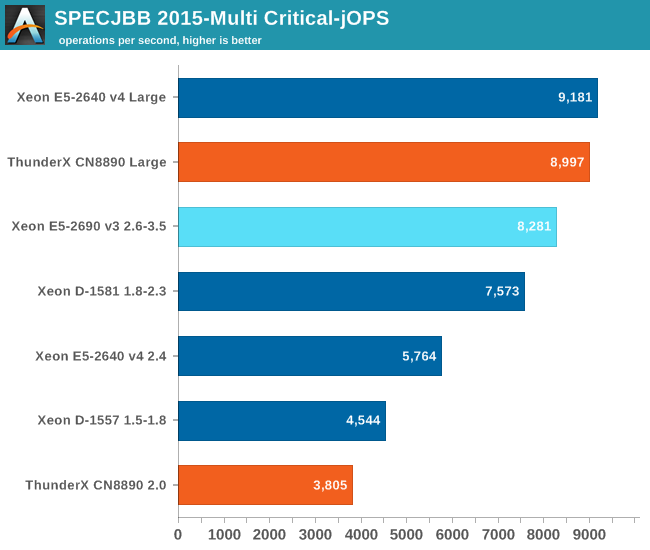Investigating Cavium's ThunderX: The First ARM Server SoC With Ambition
by Johan De Gelas on June 15, 2016 8:00 AM EST- Posted in
- SoCs
- IT Computing
- Enterprise
- Enterprise CPUs
- Microserver
- Cavium
Java Performance
The SPECjbb 2015 benchmark has "a usage model based on a world-wide supermarket company with an IT infrastructure that handles a mix of point-of-sale requests, online purchases, and data-mining operations." It uses the latest Java 7 features and makes use of XML, compressed communication, and messaging with security.

We tested with four groups of transaction injectors and backends. The Java version was OpenJDK 1.8.0_91.
We applied relatively basic tuning to mimic real-world use, while aiming to fit everything inside a server with 64 GB of RAM (to be able to compare to lower end systems):
"-server -Xmx8G -Xms8G -Xmn4G -XX:+AlwaysPreTouch -XX:+UseLargePages"
With these settings, the benchmark takes about 43-55GB of RAM. Java tends to consume more RAM as more core/threads are involved. Therefore, we also tested the Xeon E5-2640v4 and ThunderX with these settings:
"-server -Xmx24G -Xms24G -Xmn16G -XX:+AlwaysPreTouch -XX:+UseLargePages"
The setting above uses about 115 GB. The labels "large" ("large memory footprint") report the performance of these settings. We did not give the Xeon D-1581 the same treatment as we wanted to mimic the fact that the Xeon has only 4 DIMM slots, while the Xeon E5 and ThunderX have (at least) eight.
The first metric is basically maximum throughput.

Notice how the Xeon D-1581 beats the Xeon E5-2640 in a typical throughput situation by 8%, while the SPECint_rate numbers told us that the Xeon E5 would be slightly faster. It is a typical example of how running parallel instances overemphasizes bandwidth. The extra 6 cores (@2.1 GHz) push the Xeon D past the Xeon E5 (10 cores@ 2.6 GHz) despite the fact that the Xeon D has only half the bandwidth available.
The ThunderX offers low end Xeon E5 performance, but that still a lot better than what we would have expected from the SPECint_rate numbers (Dual socket ThunderX = Xeon-D). Once we offer more memory to ThunderX, performance goes up by 14%. The Xeon E5 gets a 10% performance boost.
The Critical-jOPS metric is a throughput metric under response time constraint.

The critical jOPS is the most important metric as it shows how many requests can be served in a timely manner. At first we though that the lack of single threaded performance to run the heavier pieces of Java code fast enough is what made the ThunderX so much slower than the rest of the pack.
However, the 48 threads were mostly hindered by the lack of memory per thread. Once we offer enough memory to the 48-headed ThunderX, performance explodes: it is multiplied by 2.4x! The Xeon E5 benefits too, but performance is "only" 60% higher. Thanks to the DRAM breathing room, the ThunderX moves from "slower than low end Xeon D" to "midrange Xeon E5" territory.










82 Comments
View All Comments
TheinsanegamerN - Thursday, June 16, 2016 - link
While you are right on the actual age of the chip, if you dont compare efficiency on different nodes, how on earth would you know if you made any progress?Unless you are suggesting that one should never compare one generation of chips to another, which is simply ludicrous. Where is this "you cane compare two different nodes" mindset coming from? I've seen it in the GPU forums as well, and it makes no sense.
shelbystripes - Wednesday, June 15, 2016 - link
The E5-2600 v3 is a Haswell part, meaning it's Intel's second ("tock") core design on 22nm. So not only is this a smaller process, it's a second-gen optimization on a smaller process.For a first-gen 28nm part that includes power-hungry features like multiple 10GbE, these are some very promising initial results. A 14nm die shrink should create some real improvements off the bat in terms of performance per watt, and further optimizations from there should make this thing really shine.
Given that Intel hasn't cracked 10nm at all yet, and it'll take a while for 10nm Xeons to show up once they do, Cavium has room to play catch-up. I mean, hell, they're keeping up/surpassing Xeon D in some use cases NOW, and that's a 14nm part. What Cavium needs most is power optimization at this point, and I'm sure they'll get there in time.
Michael Bay - Thursday, June 16, 2016 - link
Good to know Intel is keeping you up to date with what`s happening in their uv labs.rahvin - Thursday, June 16, 2016 - link
Last I saw Intel is already running their test fabs at 10nm. Once they perfect it in the test fabs it only takes them about 6 months to roll it into a full scale fab. Maybe you an point to this source that indicates Intel has failed at 10nm.kgardas - Wednesday, June 15, 2016 - link
Nice article, but really looking to see testing of ThunderX2 and X-Gene 3. Will be interesting as Intel seems to be kind of struggling with single-threaded performance recently...Drazick - Wednesday, June 15, 2016 - link
Just a question.You emphasized the performance are x3 instead of x5 but I bet Intel used Intel ICC for those tests.
Intel works hard on their Compilers and anyone who wants to extract the best of Intel CPU uses them as well.
Since CPU means Compilers, if Intel has advantage on that department you should show that as well.
Namely give us some results using Intel ICC.
Thank You.
UrQuan3 - Wednesday, June 15, 2016 - link
Of course, if Anandtech uses ICC, they should use better flags in gcc for ARM/ThunderX as well (core specific flags, NEON, etc). Both ICC and targeted flags give improvements. Often large ones. This was a generic test.JohanAnandtech - Thursday, June 16, 2016 - link
For integer workloads, ICC is not that much faster than gcc (See Andreas Stiller's work). And there is the fact that ICC requires licensing and other time consuming stuff. From a linux developer/administrator perspective, it is much easier just to use gcc, you simply install it from repositories, no licensing headaches and very decent performance (about 90% of icc). So tha vast majority of the **NON HPC ** software is compiled with gcc. Our added value is that we show how the processors compare with the most popular compiler on linux. That is the big difference between benchmarking to put a CPU in the best light and benchmarking to show what most people will probably experience.Until Intel makes ICC part of the typical linux ecosystem, it is not an advantage at all in most non-HPC software.
patrickjp93 - Friday, June 17, 2016 - link
His work is woefully incomplete, lacking any analysis on vectorized integer workloads, which Intel destroys GCC in to the tune of a 40% lead.phoenix_rizzen - Wednesday, June 15, 2016 - link
"The one disadvantage of all Supermicro boards remains their Java-based remote management system. It is a hassle to get it working securely (Java security is a user unfriendly mess), and it lacks some features like booting into the BIOS configuration system, which saves time."It's IPMI, you can use any IPMI client to connect to it. Once you give it an IP and password in the BIOS, you can connect to it using your IPMI client of choice. There's also a web interface that provides most of the features of their Java client (I think that uses Java as well, but just for the console).
For our SuperMicro servers, I just use ipmitool from my Linux station and have full access to the console over the network, including booting it into the BIOS, managing the power states, and even connecting to the serial console over the network.
Not sure why you'd consider a full IPMI 2.0 implementation a downside just because the default client sucks.